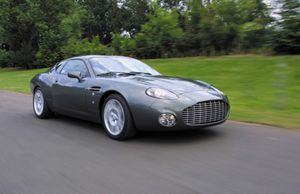.
Aston Martin DB AR1

| |
| Aston Martin DB7 Zagato and DB AR1 | |
|---|---|
| Aston Martin | |
| aka | Aston Martin DB7 |
| Production | 2003-2004 of 99 AR1 and 99 DB7 Zagato |
| Class | Super-Luxury |
| Body Style | Coupe/Convertible |
| Length | |
| Width | |
| Height | |
| Wheelbase | |
| Weight | 1740 kg |
| Transmission | 6-speed Manual |
| Engine | 6.0 litre V12 |
| Power | 435 hp |
| Similar | Aston Martin DB7 Ferrari 575M Superamerica Lamborghini Murcielago |
| Designer | Andrea Zagato |
Super-Aston
By 2003, Aston Martin, as a company, were doing extremely well. After the dull days of the late 1980s and early 1990s, the buy out by Ford was beginning to pay off, with the company releasing some very accomplished sports cars - one of which was the DB7, dubbed 'the saviour of Aston Martin' by motoring press.
But by now the DB7 was becoming a bit long in the tooth. The company was itching to replace it, and had a number of new models waiting patiently under dust sheets. The date was set for the DB7's withdrawal, but Aston Martin decided to send the car off with a final flourish - a special model - and contracted Zagato to set to work on the project.
The Project
The design house of Zagato was chosen by A.M due to the strong links that the two companies shared - after all, Zagato had penned a special model for A.M back in the 1980s. Before initial work began on the cars, the concept was outlined to A.M's best customers - who were reeled in by the promise of a very limited production run of ninety-nine cabriolets and ninety-nine coupes. The order books were filled quickly, and the project was greenlighted.
The car used a DB7 Volante as a basis, but the chassis was chopped by 27 mm.
The bodywork used the standard DB7 as a silhouette, and mixed past with future. The long, sweeping bonnet envoked memories of old A.M Le Mans racers, and the large air intake, set low to the road, was much like that of the A.M cars from the 1960s. The coupe's featured a unique 'double-bubble', designed to hark back to the days when sports cars' buyers needed extra space for when wearing helmets. However, the bubble shape continued rearwards, and onto the rear screen - providing a challenge for the glaziers, as this had seldom been tried on a production car. A pert rear finished off the Zagato's lissom form, with a small ducktail spoiler, huge circular exhaust pipes and mirroring rear lights. It was an automotive art form.
The Market
Dr. Ulrich Bez decided to use the Zagato as a showcase of the company's abilities to produce low-production, highly-specialised automobiles, and as such the Zagato and AR1 were sold at high prices. A sticker price of $250,000 was announced when the car went on sale - but almost all had been snapped up by collectors and enthusiasts before the project had even been confirmed.
The AR1 was built with the US market in mind - the clue was in the name, which stood for American Roadster 1. As such, all but one were produced in left-hand drive form, and most found their way Stateside, where their laughable weather protection was not a problem. However, the single right-hand drive example, a light green metallic car, remained in the UK, along with many of the coupes. The cars were very highly sought after, and they sold out within a matter of months from going on sale.
One example that was never sold was DB7 Zagato, chassis 100. Despite promising to produce only 99 examples, demand was unusually high, and A.M produced another coupe for British magazine road testers. The car, black exterior, remains in the hands of Aston Martin, and can be seen in their museum.










